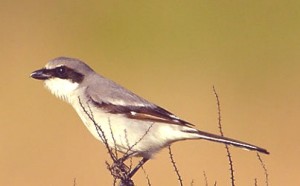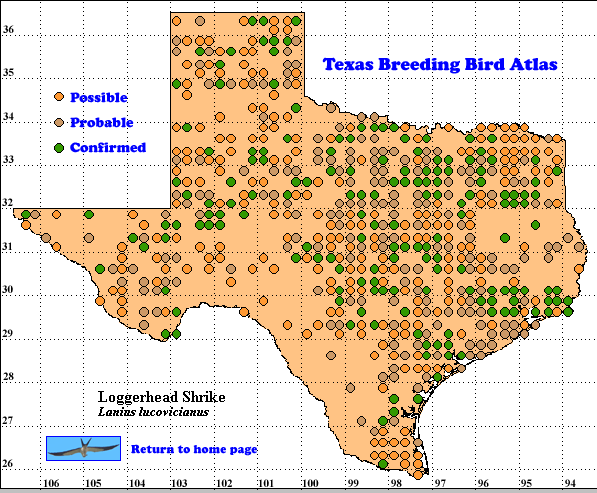The Loggerhead Shrike, commonly known as the `butcherbird’ for its habit of impaling prey on sharp objects such as thorns and barbed wire fences, breeds primarily in pastures from the southern sections of the Canadian prairie provinces south to northern Sinaloa and Oaxaca in Mexico and from central Washington and California east to Virginia and Florida in the United States. Northern populations migrate south and winter from the southern half of the United States to Chiapas, Mexico (DeGraaf et al. 1991; Yosef 1996).
DISTRIBUTION: Historically, the Loggerhead Shrike was reported throughout Texas and was considered locally common to uncommon in the northern half of the state (Oberholser 1974). Based on the 1987-1992 Texas Breeding Bird Atlas (TBBA) data, the current distribution is similar to that reported by Oberholser (1974). The only difference detected was the occurrence of breeding records in the Pineywoods region of east Texas. where Oberholser (1974) did not report breeding.. Suitable breeding habitat for the Loggerhead Shrike has probably increased in some areas of the Pineywoods due to urban development and clearing.
SEASONAL OCCURRENCE: In the Texas Panhandle Seyffert (1994) reported the Loggerhead Shrike to be common in spring and fall and uncommon in summer and winter. Pulich (1988) described its current status in north-central Texas as locally uncommon to fairly common in summer and fairly common to common winter resident due to an influx of winter visitors from areas north of Texas. In southwest and south-central Texas this species is a common spring, fall, and winter resident, but an uncommon summer resident (Kutac and Caran 1994, Wauer 1996). In southern Texas Rappole and Blacklock (1994) reported this species as uncommon to rare in summer. Along the coastal bend of Texas, the Loggerhead Shrike is reported as rare in summer and common in fall and winter (Rappole and Blacklock 1985).
The Loggerhead Shrike breeding season in Texas is protracted, extending from March until September (Oberholser 1974; Rappole and Blacklock 1994). The early date for eggs is March 6 while the latest record for young is early October (Oberholser 1974; Rappole and Blacklock 1994). Analysis of TBBA data from 1987 to 1992 indicates Loggerhead Shrikes are fairly difficult to confirm as breeding birds (i.e., 21% confirmed).
BREEDING HABITAT: Loggerhead Shrikes breed in open country with low vegetation and nest in scattered trees, thorny shrubs, hedgerows, and wood margins (Oberholser 1974, Yosef 1996). Open-cup nests, constructed of twigs, plant fibers, soft cottony and wooly materials, hair, feathers, rags, or papers and are placed in a crotch or on a large tree branch below the crown of a tree or shrub (Godfrey 1986, Ehrlich et al. 1988). Nests have been found from 1.5 to 6 m (4.9 to 19.7 ft) high and are usually hidden below the crown (Godfrey 1986).
STATUS: Tile Loggerhead Shrike is declining in Texas. North American Breeding Bird Survey data for Texas from 1966 to 2005 indicate a statistically significant -5.1% average annual population change for Loggerhead Shrike with a similar -4.4% change for the 1980-2005 period (Sauer et al. 2005). Analysis of TBBA data (1987-1992) also revealed a decline for Loggerhead Shrike. The number of confirmed breeding Loggerhead Shrikes decreased from 52 in 1987 to 20 in 1992. Although no substantial decreases were noted in the total number of confirmed, probable, and possible breeding records from 1987 to 1991 (i.e., 188 to 164). A significant drop was noted when a total of only 106 confirmed, probable, and possible breeding records were recorded in 1992.
Although a specific cause or causes have not been determined, it has been hypothesized that changes in land use practices, spraying of biocides, and competition with species that are more tolerant of human-induced changes, are the major factors contributing to the decline of the Loggerhead Shrike (Yosef 1996). In the early 21st century, this species is now considered rare to locally common in Texas (Lockwood and Freeman 2004).
Text by Ross P. Rasmussen and Joseph B. Kaskey (Posted with updates 2006)
Literature cited.
DeGraaf, R. M., V. E. Scott, R. H. Hamre, L. Ernst, and S. H. Anderson. 1991. Forest and rangeland birds of the United States: natural history and habitat use. U.S. Department of Agriculture, Forest Service, Agriculture Handbook 688.
Ehrlich, P. R., D. S. Dobkin, and D. Wheye. 1988. The birder’s handbook: a field guide to the natural history of North American birds. Simon & Schuster, Inc. New York.
Godfrey, W. E. 1986. Birds of Canada. Rev. ed. National Museum of Natural Sciences, National Museum of Canada, Ottawa.
Kutac, E. A., and S.C. Caran. 1994. Birds and other wildlife of South Central Texas. University of Texas, Austin.
Lockwood, M. W. and B. Freeman. 2004. The TOS handbook of Texas birds. Texas A&M University Press, College Station.
Oberholser, H. C. 1974. The bird life of Texas. University of Texas Press, Austin.
Pulich, W. H. 1988. The birds of north central Texas. Texas A&M, College Station.
Rappole, J. H. and G. W. Blacklock. 1994. Birds of Texas. Texas A&M University Press, College Station.
Sauer, J. R., J. E. Hines, and J. Fallon. 2005. The North American Breeding Bird Survey, results and analysis 1966-2005. Version 6.2 2006. USGS Patuxent Wildlife Research Center, Laurel MD < http://www.mbr-pwrc.usgs.gov/bbs>
Seyffert, K. D. 1994. Checklist of birds – Pantex plant Site, Carson County, Texas. Prepared for U.S. Department of Energy.
Wauer, R. H. 1996. A field guide to birds of the Big Bend. 2nd ed. Gulf Publishing, TX..
Yosef, R. `996. Loggerhead Shrike (Lanius ludovicianus). In The birds of North America, No. 231 (A. Poole and F. Gill, eds.). The Birds of North America, Inc., Philadelphia, PA.

